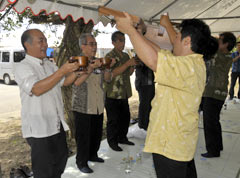Sutsuupunaka: celebration of a full harvest in Tarama Village

Wishing for a year with a good harvest with the vocal accompaniment of villagers, invited guests drink libation at Nagashiga, a ceremony site in Tarama Village in the afternoon of June 7.
June 8, 2011 Ryukyu Shimpo
On June 6 and 7, the harvest festival Sutsuupunaka was held in four sites in Tarama Village with all the villagers wishing for a year with a good harvest.
From late in the evening on June 6 into the early hours of June 7, elders sang divine songs and villagers conducted akatsukinigai, in which they pass around libation offerings in square plates and saucers known as yunaus.
From around noon to the evening of June 7, six tsukasa, or women who administers the ritual, and invited guests such as Masaaki Shimoji, visited the four ceremony sites: Nagashiga, Fudaya, Piejuni and Areeki, where they drank libation and wished for a year of good harvest with the vocal accompaniment of the villagers, “Yunatoorega, yuitoorega, heeya, yakka, yakka, yakka.”
Along with the “August Dance (8-gatsu odori),” Sutsuupunaka is one of Tarama Village’s traditional feature events. It was designated as an intangible folk cultural asset for the village in 1983.
Based on their roles, groups called za are formed for each of the four ceremony sites: the rojin-za or churou-za for the elders, the kanjin-za which oversees the running of the ritual, the busha-za which makes and serves libation, the imu-za which catches fish for offerings, and the kuban-za which cooks the food.
Twenty-seven year-old Kakuei Toguchi, who joined the busha-za in Piejuni this year, said, “It was a lot of fun, but at the same time was really hard. I would like to learn the correct way of doing it in order to pass it on to our juniors in future.”
(English Translation by T&CT, Mark Ealey)
Previous Article:Fresh traces suggesting that dugong ate seaweed further out in Oura Bay
Next Article:Novelist describes his memory of the land taken by the U.S. military
[Similar Articles]
- Sutsuupunaka celebration for a full harvest held in Tarama
- Tarama Island hosts Stuupunaka festival and prays for good harvest
- Tarama traditional ceremony “Upuri” for sinking insect pests into the sea in prayer for a bountiful harves
- August dance festival held on Tarama wishing for a good harvest
- Shinugu: Ada’s ancient Okinawan harvest ritual
 Webcam(Kokusai Street)
Webcam(Kokusai Street)


